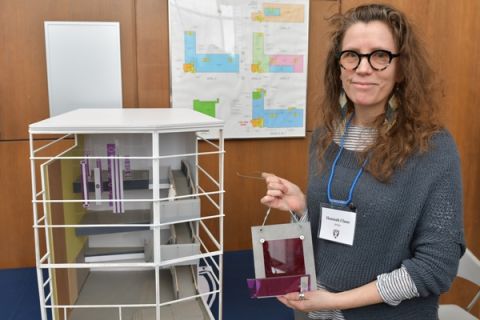
“Words that are lasting,” an artwork by Montreal (Tiohtià:ke) visual artist Hannah Claus that is visually stunning and infused with historical symbolism, has emerged as the winning entry in the first-ever Indigenous Art Commission competition at Queen’s Law. That initiative is an important element of the law school’s multifaceted response to the Calls to Action of Canada’s Truth and Reconciliation Commission.
Claus’s vision involves a suspended art installation based on wampum belts that will hang from the ceiling in the law school's atrium airy expanse. Made from translucent purple-coloured and frosted clear acrylic sheets, these laser-cut forms will interplay with the natural light that floods the atrium.
“I’m elated to have my project chosen as the artwork,” says Claus. “Wampum belts are mnemonic aids utilized by the Haudenosaunee and other Indigenous peoples within oral nation-to-nation agreements. They represent legal documents as reflected in this distinct worldview. It seems a fitting acknowledgement, as Queen’s University is located on traditional Haudenosaunee and Anishinaabe territory.”
That is a truth that resonated with the 12 members of the committee who chose the winning entry in the Indigenous Law Commission. Says Dean Bill Flanagan, the group’s chairperson: “Hannah’s art installation will beautifully represent Indigenous legal traditions and reflect part of the commitment of Queen’s Law to respond to the calls to action in the Truth and Reconciliation Report.”
Committee member Kanonhsyonne (Janice C. Hill), Director of the university’s Office of Indigenous Initiatives, agrees. “The representation of wampum in the Faculty is representative of the oldest agreements or contracts between not only Indigenous peoples and settlers, but amongst Indigenous peoples as well,” she notes.
“It’s most appropriate given there are wampum agreements between Haudenosaunee and Anishinaabe peoples, and so this work is representative of both groups of Indigenous peoples acknowledged as the original landholders.”
This is a reality of which Hannah Claus – being a visual artist of English and Kanien'kehÁ:ka / Mohawk ancestries and a member of the Tyendinaga – Mohawks of the Bay of Quinte – has long been aware.
A 1997 graduate of the Ontario College of Art and Design, she earned a Master of Fine Arts degree from Concordia University in 2004 and now teaches contemporary Indigenous art as a sessional lecturer at Kiuna, a First Nations post-secondary institution, in Odanak, Quebec.
Claus’s artworks have appeared in exhibitions across Canada and the United States, as well as in Germany, Switzerland, Mexico, and Chile. In addition, they are included in various public collections, among them the Canada Council Art Bank, the City of Montreal, and the Department of Global Affairs Canada.
Concurrent with her studio practice, Claus serves as vice-president on the board of directors for the Aboriginal Curatorial Collective, an Indigenous national arts service organization for Canada’s First Nations, Inuit, and Métis artists and curators.
Claus is now at work creating “words that are lasting,” the artwork she has envisioned for the Queen's Law atrium. “The timeline for its installation is still to be determined, but I hope it will happen sometime this fall.” she says.
She plans to visit campus in June to discuss plans for that. When she does so, she also will sit down with renowned Indigenous architect Douglas Cardinal, a member of the Indigenous Art Commission selection committee (who will receive an honorary Doctor of Law degree at the law school’s June 6 convocation ceremonies) to record a video that will highlight and explore the themes embodied in the “words that are lasting.”
By Ken Cuthbertson